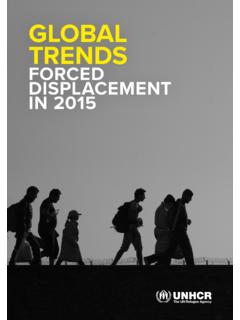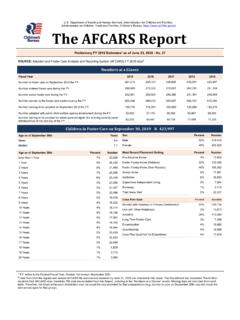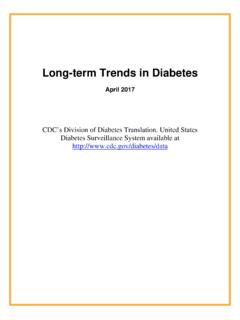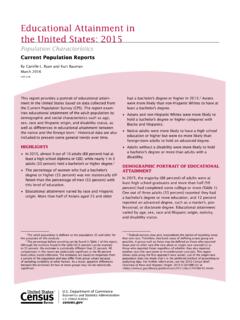Transcription of OBESITY AND OVERWEIGHT - WHO
1 OBESITY AND OVERWEIGHTO besity has reached epidemic proportions globally, withmore than 1 billion adults OVERWEIGHT - at least 300 millionof them clinically obese - and is a major contributor to theglobal burden of chronic disease and disability. Often coexisting in developing countries with under-nutrition, OBESITY is a complex condition, with serious social and psychological dimensions, affecting virtually all ages andsocioeconomic consumption of more energy-dense, nutrient-poor foods with high levels of sugar and saturated fats,combined with reduced physical activity, have led to obesityrates that have risen three-fold or more since 1980 insome areas of North America, the United Kingdom,Eastern Europe, the Middle East, the Pacific Islands,Australasia and OBESITY epidemic is not restrictedto industrialized societies; this increase is often faster indeveloping countries than in the developed and OVERWEIGHT pose a major risk for serious diet-related chronic diseases, including type 2 diabetes,cardiovascular disease, hypertension and stroke, and certain forms of cancer.
2 The health consequences rangefrom increased risk of premature death, to serious chronicconditions that reduce the overall quality of life. Of especialconcern is the increasing incidence of child IS THIS HAPPENING?The rising epidemic reflects the profound changes in society and in behavioural patterns of communities overrecent genes are important in determininga person's susceptibility to weight gain, energy balance isdetermined by calorie intake and physical activity. Thussocietal changes and worldwide nutrition transition aredriving the OBESITY epidemic. Economic growth,modernization, urbanization and globalization of food markets are just some of the forces thought to underliethe incomes rise and populations become more urban,diets high in complex carbohydrates give way to more varied diets with a higher proportion of fats, saturatedfats and sugars. At the same time, large shifts towards lessphysically demanding work have been observed worldwide.
3 Moves towards less physical activity are alsofound in the increasing use of automated transport,technology in the home, and more passive leisure DO WE DEFINE OBESITY ANDOVERWEIGHT?The prevalence of OVERWEIGHT and OBESITY is commonlyassessed by using body mass index (BMI), defined as theweight in kilograms divided by the square of the height inmetres (kg/m2). A BMI over 25 kg/m2is defined as OVERWEIGHT , and a BMI of over 30 kg/m2as obese. Thesemarkers provide common benchmarks for assessment, butthe risks of disease in all populations can increase progressively from lower BMI mean BMI levels of 22-23 kg/m2are found in Africaand Asia, while levels of 25-27 kg/m2are prevalent acrossNorth America, Europe, and in some Latin American,North African and Pacific Island countries. BMI increasesamongst middle-aged elderly people, who are at the greatest risk of health complications. In countries undergoing nutrition transition, overnutrition often co-exists with undernutrition.
4 People with a BMI kg/m2tend to be distribution of BMI is shifting upwards in many populations. And recent studies have shown that peoplewho were undernourished in early life and then becomeobese in adulthood, tend to develop conditions such ashigh blood pressure, heart disease and diabetes at an earlier age and in more severe form than those who werenever HEALTH ORGANIZATIONGLOBAL STRATEGY ON DIET, PHYSICAL ACTIVITY AND HEALTHFACTS: Globally, there are more than 1 billion OVERWEIGHT adults, at least 300 million of them obese. OBESITY and OVERWEIGHT pose a major risk for chronic diseases, including type 2 diabetes,cardiovascular disease, hypertension and stroke, and certain forms of cancer. The key causes are increased consumption of energy-dense foods high in saturated fats andsugars, and reduced physical AND OVERWEIGHT WHO 2003DR P. PUSKAW orld Health OrganizationTel:+41-22-791 4703 Fax:+41-22-791 4186 Email: C.
5 NISHIDAW orld Health OrganizationTel:+41-22-791 3317 Fax:+41-22-791 4156 Email: D. PORTERW orld Health OrganizationTel:+41-22-791 3774 Fax:+41-22-791 4186 Email: CONTACTSOBESITY AND OVERWEIGHTTHE EXTENT OF THE PROBLEMC urrently more than 1 billion adults are OVERWEIGHT - andat least 300 million of them are clinically obese. Currentobesity levels range from below 5% in China, Japan andcertain African nations, to over 75% in urban Samoa. Buteven in relatively low prevalence countries like China, ratesare almost 20% in some OBESITY is already epidemic in some areas andon the rise in others. An estimated million childrenunder five are estimated to be OVERWEIGHT to the US Surgeon General, in the USA thenumber of OVERWEIGHT children has doubled and the number of OVERWEIGHT adolescents has trebled since prevalence of obese children aged 6-to-11 years hasmore than doubled since the 1960s. OBESITY prevalence inyouths aged 12-17 has increased dramatically from 5% to13% in boys and from 5% to 9% in girls between 1966-70and 1988-91 in the USA.
6 The problem is global and increasingly extends into the developing world;for example, in Thailand the prevalence of OBESITY in 5-to-12 year olds children rose to 15-6% in justtwo accounts for 2-6% of total health care costs inseveral developed countries; some estimates put the figureas high as 7%. The true costs are undoubtedly muchgreater as not all OBESITY -related conditions are included inthe DOES EXCESS BODY FAT IMPACTHEALTH? OVERWEIGHT and OBESITY lead to adverse metabolic effectson blood pressure, cholesterol, triglycerides and insulinresistance. Some confusion of the consequences of OBESITY arise because researchers have used different BMIcut-offs, and because the presence of many medical conditions involved in the development of OBESITY mayconfuse the effects of OBESITY non-fatal, but debilitating health problems associatedwith OBESITY include respiratory difficulties, chronic musculoskeletal problems, skin problems and more life-threatening problems fall into four mainareas: CVD problems; conditions associated with insulinresistance such as type 2 diabetes; certain types of cancers,especially the hormonally related and large-bowel cancers;and gallbladder likelihood of developing Type 2 diabetes and hypertension rises steeply with increasing body to older adults for most of the 20th century, thisdisease now affects obese children even before 85% of people with diabetes are type 2, andof these, 90% are obese or OVERWEIGHT .
7 And this is increasingly becoming a developing world problem. In1995, the Emerging Market Economies had the highestnumber of diabetics. If current trends continue, India andthe Middle Eastern crescent will have taken over by increases would also be observed in China, LatinAmerica and the Caribbean, and the rest of BMI also increases the risks of cancer of the breast,colon, prostrate, endometroium, kidney and OVERWEIGHT and OBESITY contribute significantly toosteoarthritis, a major cause of disability in OBESITY should be considered a disease in itsown right, it is also one of the key risk factors for otherchronic diseases together with smoking, high blood pressure and high blood cholesterol. In the analyses carried out for World Health Report 2002, approximately58% of diabetes and 21% of ischaemic heart disease and 8-42% of certain cancers globally were attributable to aBMI above 21 CAN WE DO ABOUT IT?
8 Effective weight management forindividuals and groups at risk ofdeveloping OBESITY involves arange of long-term include prevention, weightmaintenance, management of co-morbidities and weight should be part of an integrated, multi-sectoral,population-based approach,which includes environmental support for healthy dietsand regular physical activity. Key elements include: Creating supportive population-based environments through public policies that promote the availability andaccessibility of a variety of low-fat, high-fibre foods, andthat provide opportunities for physical activity. Promoting healthy behaviours to encourage, motivateand enable individuals to lose weight by:- eating more fruit and vegetables, as well as nuts andwhole grains;- engaging in daily moderate physical activity for at least30 minutes;- cutting the amount of fatty, sugary foods in the diet;- moving from saturated animal-based fats to unsaturatedvegetable-oil based fats.
9 Mounting a clinical response to the existing burden of OBESITY and associated conditions through clinical programmes and staff training to ensure effective support for those affected to lose weight or avoid further weight gain. WHO 2003















